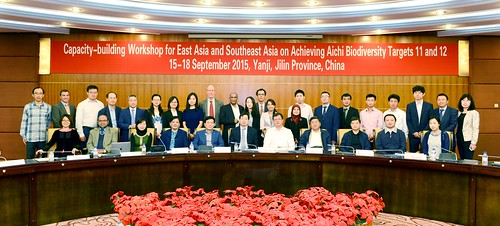by EAAFP Secretariat

©CBD Secretariat
Spike Millington, Chief Executive of the East Asian–Australasian Flyway Partnership (EAAFP) gave a presentation on the conservation of migratory waterbirds and their habitats in the Flyway at the Capacity-building workshop for East Asia and Southeast Asia on achieving Aichi Biodiversity Target 11 and 12 held in Yanji, Jilin Province, China 15-18 September 2015. EAAFP brings together 34 national governments, inter-governmental (including CBD) and non-governmental organizations. All countries represented in this workshop are included in the Flyway.
Migratory waterbirds represent a significant proportion of critically endangered, as well as endangered and vulnerable species in each Flyway country (e.g. in China 5 of 9 critically endangered species are migratory waterbirds, nearly all of Korea’s and about a third of Vietnam’s threatened species are migratory waterbirds). Migratory birds face a particular challenge because they depend upon a network of sites in different countries, which currently have varying levels of protection and effective management. Some of these sites form “bottlenecks” and loss of habitat here can have a catastrophic effect on the viability of the species. Most of these bottlenecks occur in East Asia.
This serves to highlight the strong and complex inter-linkages between Target 11, focused on protection and effective management of sites, and Target 12, preventing species extinctions. It also emphasizes the need to make sure protected areas are well-connected and integrated into the wider landscape and seascape, in this case covering a series of countries, where individual species may face different threats.
The East Asian–Australasian Flyway is by far the most threatened of the nine global flyways, supporting 50 million waterbirds of which 33 are globally threatened, and many more are declining precipitously (at annual rates of 5-9%), primarily due to habitat loss, particularly of intertidal areas. In the case of the critically endangered Spoon-billed Sandpiper, annual declines have recently been over 20%. Yet of all the critical sites upon which the species depends, from its breeding grounds in Russia, through vital staging areas in China to wintering grounds in SE Asia, almost all are unprotected, and are under imminent threat from reclamation. The intertidal zone of the Yellow Sea is a critical bottleneck for many migratory waterbird species, including Spoon-billed Sandpiper. Yet it is one of the most poorly represented ecoregions in East Asia, with less than 2% protected in the three range countries. Intertidal habitats in other parts of East Asia are similarly under-represented (e.g. 0.2% of the northern Bay of Bengal in Myanmar is protected, despite 50% of this ecoregion being located in the country).
One of EAAFP’s responses to the ecological crisis faced by migratory waterbirds in East Asia is to identify a network of Flyway sites that, if protected and well-managed, can ensure the continued survival of all migratory waterbird species in the Flyway. Of almost one thousand sites of international significance, only 123 are currently in the network. This network tries to prioritize sites that may fall outside the formal protected area system of a country, but can nevertheless be managed for waterbird and habitat conservation, often with local community involvement.
Under Target 12, countries should develop action plans for critically endangered species. Since many of these species cross national borders, action plans need to be coordinated internationally. EAAFP supports Task Forces for a number of critically endangered and endangered species in the Flyway, with participation by range states, providing an existing structure and mechanism for coordinated action.
EAAFP, through its Partners (including CBD and national government agencies) and its Flyway Site Network and Species and regional Task Forces and Working Groups can significantly contribute to achieving Targets 11 and 12 in the East Asia region.
Meeting Documents: https://www.cbd.int/doc/?meeting=PAWS-2015-01




